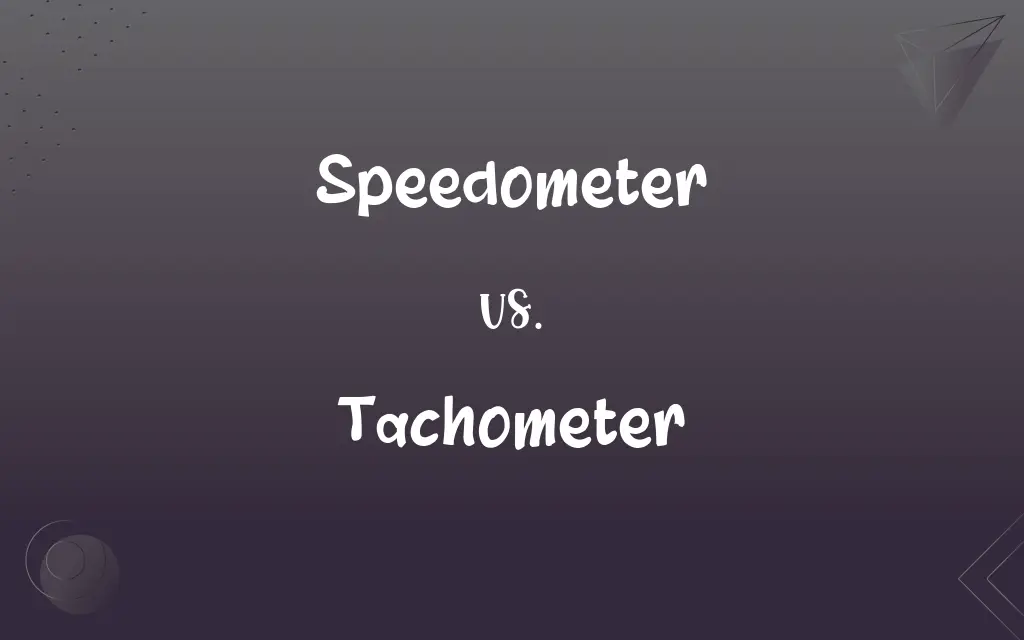Speedometer vs. Tachometer: What's the Difference?
Edited by Harlon Moss || By Janet White || Updated on July 7, 2024
A "Speedometer" measures a vehicle's speed, while a "Tachometer" indicates the engine's revolutions per minute (RPM).

Key Differences
Both "Speedometer" and "Tachometer" are instruments commonly found in vehicles, each serving a distinct purpose. The Speedometer, as its name suggests, is designed to display the speed at which a vehicle is traveling. Whether in miles per hour (mph) or kilometers per hour (km/h), this instrument provides the driver with crucial information about their current velocity, assisting them in adhering to speed limits and ensuring safe driving. Contrastingly, a "Tachometer" is tailored to convey the engine's speed in terms of revolutions per minute (RPM). This does not reflect the vehicle's speed but rather how fast the engine's crankshaft is turning.
While the "Speedometer" predominantly focuses on the vehicle's external movement, the "Tachometer" provides insight into the internal workings of the engine. This distinction emphasizes their different roles in informing the driver: one about their interaction with the road and the environment, and the other about the vehicle's internal health and performance.
Another crucial point of difference lies in their units of measurement. The Speedometer uses units of distance over time, such as mph or km/h. In contrast, the Tachometer uses RPM, a unit that solely denotes rotational speed without any reference to distance. Both instruments, however, are invaluable in ensuring both the vehicle's and the driver's safety on the road.
Comparison Chart
Primary Function
Measures vehicle's speed
Indicates engine's RPM
Unit of Measurement
Miles per hour (mph) or Kilometers per hour (km/h)
Revolutions Per Minute (RPM)
ADVERTISEMENT
Associated with
Vehicle's movement
Engine's performance
Usage
Helps adhere to speed limits
Assists in gear shifts, prevents engine over-revving
Location
Typically prominent on the dashboard
Located near or alongside the Speedometer
Speedometer and Tachometer Definitions
Speedometer
An instrument showing vehicle speed.
He glanced at the Speedometer and realized he was going over the limit.
Tachometer
Measures engine's RPM.
The Tachometer showed the engine was running at 3000 RPM.
ADVERTISEMENT
Speedometer
A gauge indicating mph or km/h.
The Speedometer in older cars might not be as accurate as in newer models.
Tachometer
A gauge for engine's revolutions.
Redlining on the Tachometer can damage the engine.
Speedometer
A device for measuring vehicular velocity.
The mechanic checked the Speedometer for any malfunctions.
Tachometer
Instrument indicating crankshaft's speed.
He checked the Tachometer before shifting gears.
Speedometer
An odometer's companion on a dashboard.
Right next to the odometer, the Speedometer read 65 mph.
Tachometer
Essential for manual transmissions.
Using the Tachometer, he knew when to shift to the next gear.
Speedometer
Essential for tracking and controlling speed.
Without a working Speedometer, you won't know how fast you're going
Tachometer
Reflects engine's internal speed.
The Tachometer's needle surged as he accelerated.
Speedometer
An instrument for indicating speed.
Tachometer
An instrument used to measure the rotations per minute of a rotating shaft.
Speedometer
An instrument for indicating distance traveled as well as rate of speed.
Tachometer
A device for measuring the revolutions per minute (RPMs) of a revolving shaft, as with the driveshaft of an automobile.
Speedometer
An odometer.
Tachometer
A device for measuring or indicating velocity or speed, as of blood, a river, a machine, etc.
Speedometer
An instrument located within the dashboard of a vehicle that measures and indicates the current speed of the vehicle.
Tachometer
An instrument for measuring the velocity, or indicating changes in the velocity, of a moving body or substance.
Speedometer
Such a device incorporating an odometer.
Tachometer
An instrument for measuring the velocity of running water in a river or canal, consisting of a wheel with inclined vanes, which is turned by the current. The rotations of the wheel are recorded by clockwork.
Speedometer
A meter fixed to a vehicle that measures and displays its speed
Tachometer
An instrument for showing at any moment the speed of a revolving shaft, consisting of a delicate revolving conical pendulum which is driven by the shaft, and the action of which by change of speed moves a pointer which indicates the speed on a graduated dial.
Tachometer
An instrument for measuring the velocity of the blood; a hæmatachometer.
Tachometer
Measuring instrument for indicating speed of rotation
FAQs
Do both instruments come standard in all cars?
Most modern vehicles have both, but their prominence may vary.
What's the main function of a Speedometer?
The Speedometer measures the vehicle's speed.
Why is the Tachometer crucial in manual cars?
It helps drivers know when to shift gears efficiently.
Can a vehicle function without a Speedometer?
While it can function, driving without knowing your speed is unsafe and illegal in many places.
What does "redlining" on a Tachometer mean?
It means the engine is operating above its recommended RPM limit.
Are digital Tachometers better than analog ones?
Both serve the same function; preference depends on the user.
Does cruise control rely on the Speedometer?
Yes, it uses the Speedometer to maintain a set speed.
Does the Tachometer measure the car's speed?
No, the Tachometer measures the engine's RPM.
Can I fix a malfunctioning Speedometer myself?
It's best to consult a mechanic for such repairs.
What's more crucial, Speedometer or Tachometer?
Both are essential for different reasons in driving.
Why does the Tachometer rise during acceleration?
As the engine works harder, its RPM increases.
How are Speedometers calibrated?
They're often calibrated using GPS or specialized equipment.
Are Speedometers and Tachometers connected?
They function independently but may be located together on the dashboard.
How can I ensure my Speedometer's accuracy?
Regular maintenance and calibrations can help.
Why does a Tachometer's reading fluctuate at idle?
Minor fluctuations are normal due to engine operations.
Is a Tachometer necessary for automatic transmissions?
Not necessary, but it still provides useful information about the engine.
Can I replace my analog Speedometer with a digital one?
Yes, but ensure compatibility and consult a professional.
Can overspeeding damage the Speedometer?
No, but consistently driving at high speeds can wear out other car components.
At what RPM should I shift gears?
It varies per vehicle, but a Tachometer helps indicate optimal points.
Can faulty Tachometers affect gear shifting?
Yes, especially in manual transmissions where RPM indications assist in shifting.
About Author
Written by
Janet WhiteJanet White has been an esteemed writer and blogger for Difference Wiki. Holding a Master's degree in Science and Medical Journalism from the prestigious Boston University, she has consistently demonstrated her expertise and passion for her field. When she's not immersed in her work, Janet relishes her time exercising, delving into a good book, and cherishing moments with friends and family.
Edited by
Harlon MossHarlon is a seasoned quality moderator and accomplished content writer for Difference Wiki. An alumnus of the prestigious University of California, he earned his degree in Computer Science. Leveraging his academic background, Harlon brings a meticulous and informed perspective to his work, ensuring content accuracy and excellence.































































